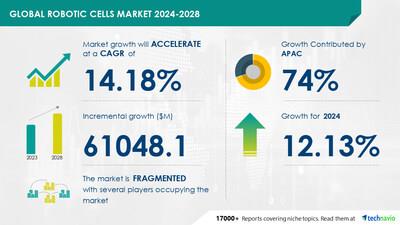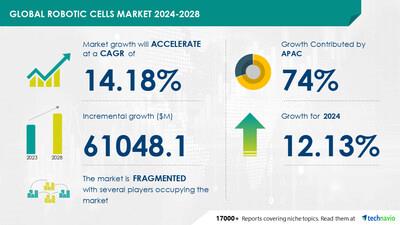
AI Is Transforming The Robotic Cells Market, Projected To Grow By USD 61 Billion From 2024-2028 Due To Technological Advances In Integration - Technavio Report
| Robotic Cells Market Scope |
|
| Report Coverage |
Details |
| Base year |
2023 |
| Historic period |
2018 - 2022 |
| Forecast period |
2024-2028 |
| Growth momentum & CAGR |
Accelerate at a CAGR of 14.18% |
| Market growth 2024-2028 |
USD 61048.1 million |
| Market structure |
Fragmented |
| YoY growth 2022-2023 (%) |
12.13 |
| Regional analysis |
APAC, Europe, North America, South America, and Middle East and Africa |
| Performing market contribution |
APAC at 74% |
| Key countries |
China, US, Japan, South Korea, and Germany |
| Key companies profiled |
ABB Ltd., ABL Automazione Spa, Amtec Solutions Group Inc., Arcos Srl, Bystronic Laser AG, Carl Cloos Schweisstechnik GmbH, Desarrollo de Maquinas y Soluciones Automaticas SL, Evomatic AB, Hitachi Ltd., HUMARD Automation SA, IPG Photonics Corp., KC Robotics Inc., MEPSA, MEXX Engineering Pty Ltd., Okuma Corp, Peak Analysis and Automation Ltd., PROMOT Automation GmbH, Remtech Systems, RITM Industry, and Scott Technology Ltd. |
Market Driver
Smart robots are autonomous machines that incorporate advanced technologies such as artificial intelligence (AI) and machine learning (ML). These robots can observe and learn from human behavior and past experiences. They can be controlled using IoT devices and applications. Major vendors are developing advanced smart robots with decision-making capabilities related to operations and problem-solving abilities in assembly and manufacturing processes. Some smart robots collaborate with human workers to perform tasks such as pick-and-place, packaging, palletizing orders, machine tending, and quality inspections. Vendors are integrating AI and ML to enhance smart robots' decision-making capabilities and enable them to recognize human faces, emotional expressions, and hand gestures. With the aim of automating manufacturing processes, companies are deploying smart robots in their facilities. For instance, XPO Logistics announced the deployment of 5,000 smart robots for functions like picking, packing, and sorting materials. Governments in Europe are encouraging the use of smart robots in various industries, and the UK government has allocated funding for care robot development. Technavio expects the integration of advanced technologies and government funding to enhance smart robots' capabilities, such as force sensing, speech recognition, and emotion sensing, leading to the growth of the global robotic cells market.
Robotic cells are becoming increasingly popular in various industries due to their flexibility and ability to integrate with digital technologies like IoT and machine learning. Multinational corporations are investing in advanced robotics technologies for automation solutions, including collaborative robots that work alongside humans. Industry 4.0 technologies, such as cloud computing and data analytics, enable real-time monitoring and remote control of robot cells. Safety is a top priority, with safety measures including safety fencing, guards, and interlocks. Flexibility is key, with navigation and mapping technologies allowing robots to adapt to changing environments. Aerospace, manufacturing, logistics, healthcare, and last-mile deliveries are just a few industries benefiting from these advanced automation solutions. Risk assessments are crucial, with artificial intelligence and machine learning integration helping to identify potential hazards and optimize performance. Overall, the future of robot cells is bright, with continued innovation and integration of Industry 4.0 technologies driving growth.
Explore a 360° Analysis of the Market: Unveil the Impact of AI. For complete insights- Request Sample!
Market
Challenges
-
System integrators play a crucial role in the deployment of industrial robotic cells, involving contract signing, competitive bidding, and evaluations. Vendors must innovate to streamline these pre-purchase processes, reducing costs and time for end-users. Robotic cell integration includes software packages for robot programming and easy integration, sold by vendors, independent software vendors, and OEMs. These solutions help companies create simulations and virtual factories, aiding in ideal robot selection. However, high costs for on-site training sessions and system engineering investments can hinder market growth. To make these services more cost-effective, system integrators must optimize their business models, adopting technologies like virtual commissioning, off-line programming, and simulation. End-user employees require relevant training, adding to the total cost of ownership. Therefore, it is essential for system integrators to focus on cost reduction and ease of implementation to drive market growth.
The Robotic Cells Market is experiencing significant growth due to the increasing adoption of automation solutions in various industries. Industry 4.0 technologies, including robotics, IoT, and AI algorithms, are driving this trend. Robot cells are being used in manufacturing, logistics, healthcare, agriculture, construction, and more for tasks such as palletizing, handling, assembly, welding, and inspection. Challenges in this market include navigation and mapping in complex environments, risk assessment and obstacle avoidance, and safety concerns with human-robot cooperation. Robotics technologies like autonomous systems and machine learning integration are being used to address these challenges. Last-mile deliveries, automotive, and steel segments are major contributors to the market. Robot cells are being used in material handling, distribution centers, and industrial robotics for routine inspections and maintenance. Peripheral equipment like robot arms, manipulators, and self-driving forklifts are also gaining popularity. However, worker scarcity and safety concerns are major challenges. The robotics industry is continuously innovating to address these challenges, with a focus on precision and efficiency. Aluminum robot cells are being used in aluminum extrusion processes to increase productivity and reduce costs. Overall, the market is expected to grow significantly in the coming years.
For more insights on driver and challenges
-
Request a
sample report!
Segment Overview
This robotic cells market report extensively covers market segmentation by
-
1.1 Material handling
1.2 Welding and soldering
1.3 Assembly
1.4 Others
-
2.1 Turnkey cells
2.2 Custom cells
-
3.1 APAC
3.2 Europe
3.3 North America
3.4 South America
3.5 Middle East and Africa
1.1
Material handling-
The robotic cells market is experiencing significant growth due to increasing automation in manufacturing industries. Companies are investing in robotic cells to enhance productivity and reduce labor costs. Robotic cells offer flexibility, precision, and consistency in production processes. Key industries such as automotive, electronics, and pharmaceuticals are major contributors to the market's growth. Advanced technologies like collaborative robots and 3D printing are also driving innovation in the market. Overall, the robotic cells market is expected to continue its expansion in the coming years.
For more information on market segmentation with geographical analysis including forecast (2024-2028) and historic data (2017-2021) - Download a Sample Report
Research Analysis
The Robotic Cells Market is experiencing significant growth due to the increasing adoption of Industry 4.0 technologies in various sectors. Robotic cells, which include robots, automation solutions, robot arms, and manipulators, are becoming essential components of modern manufacturing and logistics processes. Robotic cells are integrated with advanced technologies such as navigation, mapping, risk assessment, obstacle avoidance, and IoT for enhanced efficiency, precision, and flexibility. In manufacturing, robotic cells are used for inspection, assembly, and material handling applications. In logistics, they are utilized for last-mile deliveries and warehousing operations. The healthcare sector also benefits from robotic cells through the use of surgical robots and automated pharmacy systems. Robotics technologies such as artificial intelligence, cloud computing, and digital technologies are integrated into robotic cells to enable advanced capabilities like autonomous navigation and real-time data processing. The integration of IoT and robotics enables remote monitoring and control of robotic cells, leading to increased productivity and cost savings. Overall, the Robotic Cells Market is poised for continued growth due to the increasing demand for automation and digitalization across various industries.
Market Research Overview
The Robotic Cells Market is experiencing significant growth due to the increasing adoption of Industry 4.0 technologies, automation solutions , and robotics in various industries. Robots and autonomous systems are being integrated with navigation, mapping, risk assessment, obstacle avoidance, and machine learning algorithms to enhance efficiency, precision, and flexibility in manufacturing, logistics, healthcare, agriculture, construction, and more. Last-mile deliveries, self-driving forklifts, and autonomous systems are revolutionizing the supply chain and distribution sectors. Robot cells are being used for palletizing, handling, assembly, welding, and inspection in industries like automotive, steel, and aluminum. The robotics industry is also embracing AI algorithms, IoT, cloud computing, and collaborative robots for human-robot cooperation. However, safety concerns are a major challenge, leading to the development of safety measures such as safety fencing, guards, interlocks, and advanced technologies for risk assessments and remote control. Multinational corporations are investing heavily in these advanced technologies to streamline operations, reduce worker scarcity, and improve routine inspections and maintenance.
Table of Contents:
1 Executive Summary
2 Market Landscape
3 Market Sizing
4 Historic Market Size
5 Five Forces Analysis
6 Market Segmentation
-
Application
-
Material Handling
Welding And Soldering
Assembly
Others
-
Turnkey Cells
Custom Cells
-
APAC
Europe
North America
South America
Middle East And Africa
7 Customer Landscape
8 Geographic Landscape
9 Drivers, Challenges, and Trends
10 Company Landscape
11 Company Analysis
12 Appendix
About Technavio
Technavio is a leading global technology research and advisory company. Their research and analysis focuses on emerging market trends and provides actionable insights to help businesses identify market opportunities and develop effective strategies to optimize their market positions.
With over 500 specialized analysts, Technavio's report library consists of more than 17,000 reports and counting, covering 800 technologies, spanning across 50 countries. Their client base consists of enterprises of all sizes, including more than 100 Fortune 500 companies. This growing client base relies on Technavio's comprehensive coverage, extensive research, and actionable market insights to identify opportunities in existing and potential markets and assess their competitive positions within changing market scenarios.
Contacts
Technavio Research
Jesse Maida
Media & Marketing Executive
US: +1 844 364 1100
UK: +44 203 893 3200
Email:
[email protected]
Website:
SOURCE Technavio

Legal Disclaimer:
MENAFN provides the
information “as is” without warranty of any kind. We do not accept
any responsibility or liability for the accuracy, content, images,
videos, licenses, completeness, legality, or reliability of the information
contained in this article. If you have any complaints or copyright
issues related to this article, kindly contact the provider above.



















Comments
No comment